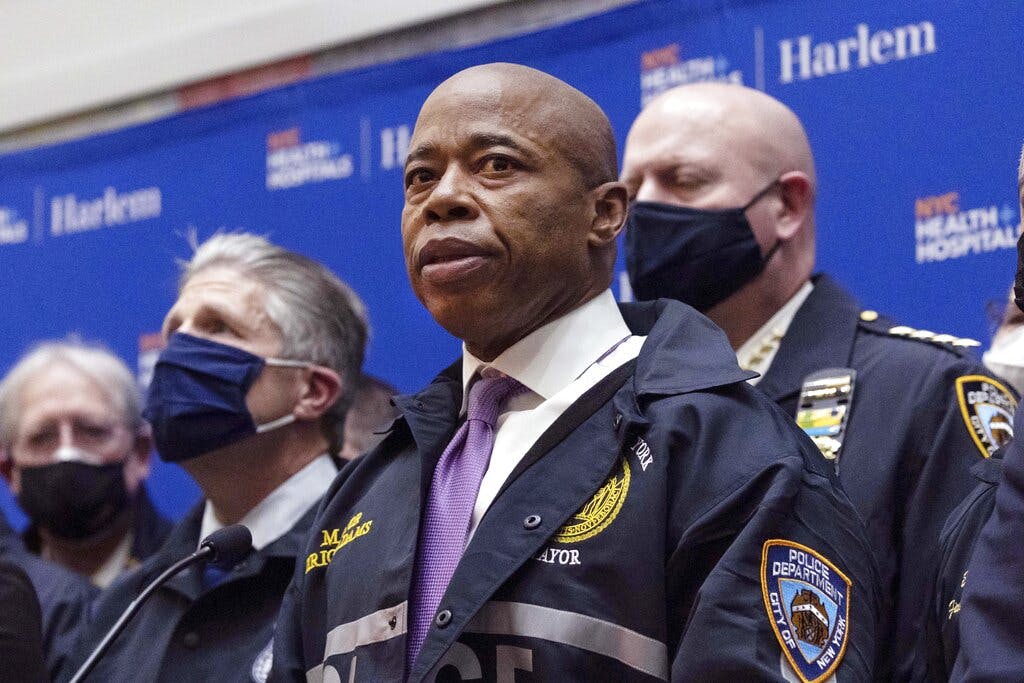New York’s Mayor Asks Washington for Help, Again
Mayor Adams has regularly called on both Washington and Albany to pass legislation to help him fight crime, an issue he staked his political name on. He so far has been met with inaction.

Mayor Adams visited Washington, D.C., this week to advocate for national gun control legislation even as an engineer of the country’s 1994 assault weapons ban says it won’t pass.
The trip comes after months of advocacy for federal gun control regulation and marks at least the third time the mayor has called on Congress or President Biden to help him combat gun violence in New York City.
The mayor has frequently argued that efforts to take illegal guns off the streets are hampered by trafficking from other states, a problem that is squarely beyond his authority.
“Common-sense gun reform must become the law of the land,” the mayor said to Congress. “And we must work together to dam all the rivers that lead to this sea of violence.”
Mr. Adams has been touting a reduction in shootings in New York City of about 10 percent this year as a victory for his administration.
Now, he is joining Representative Carolyn Maloney, who invited him to testify, and other Democrats in a push for new national gun legislation.
“I stand with President Joe Biden in calling on Congress to act now to regulate or ban assault weapons in this country,” the mayor said. “Even if we only raise the age required to buy one of these weapons, lives will be saved.”
The House has since passed a bill that would raise the age required to purchase an assault weapon to 21 from 18 as well as banning the sale of large-capacity magazines. The bill is expected to die in the Senate.
A leading figure in the push for the 1994 assault weapons ban, Richard Aborn, now the president of the Citizens Crime Commission, told the Sun that he believes an assault weapons ban, or any national legislation, is unlikely to become law.
“It absolutely should pass but it won’t,” he said. “We are much more divided, our actual identity is now tied up in our party affiliation and we have lost the ability to understand that the other side can make reasonable points, so there’s no compromise.”
Mr. Adams has made reducing shootings a cornerstone of his mayorship. He noted in his testimony that the NYPD has “taken over 3,000 illegal guns off our streets this year alone, but the guns just keep coming.”
The mayor has been petitioning Washington for help in combating gun violence in the city since soon after taking office. As early as January the mayor was meeting with President Biden to discuss the problem of illegal guns in New York City.
“We have to stop the flow of guns,” he said at a January 23 press conference. “We are removing thousands of guns off our streets, and it appears for every gun we’ve removed from the street, five are coming in.”
On February 3, he said: “We must and we will break the iron pipeline, get guns off the street, and lift our communities up. The cavalry has arrived, and we will tackle the gun violence epidemic head on to build a safer, stronger city.”
The “iron pipeline” is the name given to the gun-trafficking network that works to illegally bring guns into New York from states with less restrictive laws.
Inaction in Washington and Albany could pose a real threat to the mayor and his approval rating, as he has staked his political name on fighting crime.
A recent Siena College poll found that Mr. Adams enjoyed only a 29 percent approval rating with 64 percent of voters believing he is doing a “fair or poor job.”
Crime appears to be at least one driving factor in his low approval rating, with only 21 percent of voters saying the mayor is doing an excellent or good job fighting crime and 74 percent giving him a negative rating.
According to the attorney general’s office, more than 70 percent of all guns in New York State and more than 80 percent of guns in New York City are bought out of state.
Their estimates are based on data from the Federal Bureau of Alcohol tobacco Firearms and Explosives, which collects information on where guns are purchased and where they are recovered if picked up by law enforcement.

